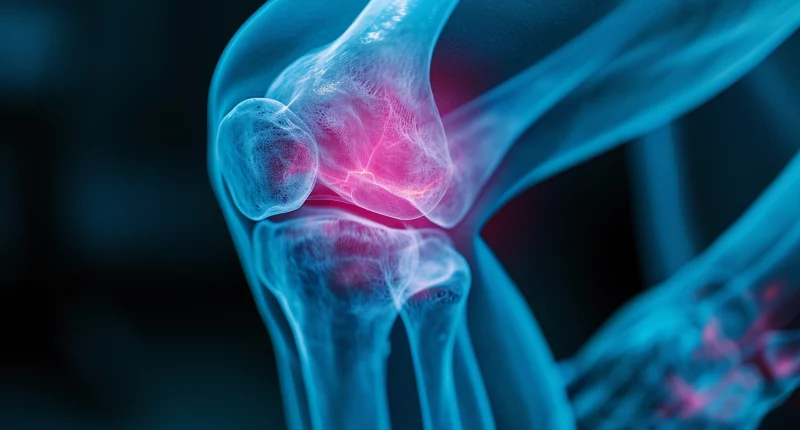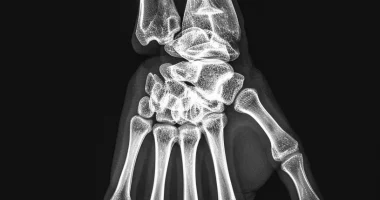Patellar fracture
About the disease
A patellar fracture is damage to the integrity of the bone that covers the knee joint from the front.
Patellar fractures account for 0.5 to 1.5% of total fractures. They are categorized as “minor” injuries. However, this underestimation is not entirely justified. For example, after fragility fractures, knee joint damage is increased – degenerative-dystrophic processes and contractures may develop.
Diagnosis of this injury is based on objective examination and radiographic findings. The sign of a fracture will be the detection of a line of damage in the area of the examined bone. Treatment of fractures of the patella without displacement is conservative. However, in severe cases, the indications for surgical intervention are expanded. Depending on the clinical features of the injury, different variants of surgery can be used – connecting the fragments with spokes and screws, removal of the severely damaged part of the patella, and arthroscopic interventions. Successful treatment of patella fractures depends not only on primary care but also on the patient’s postoperative rehabilitation. It is necessary to start early vertical loading of the injured limb and gradual joint flexion with increasing amplitude.
Types of patella fracture
In practical traumatology, the following types of patella fractures are distinguished:
- Traumatic injury with displacement of bone fragments and patella injury without displacement of bone fragments. Displacement is verified when the bone segments are 3 mm or more apart or the patella “moves away” from the articular surface of the femur by more than 2 cm.
- According to the degree of involvement of the knee joint, the patellar fracture is divided into three types: Type A (the line of injury extends outside the knee joint); Type B (partially intra-articular injury); Type C (intra-articular fracture, which is characterized by the greatest severity).
- Regarding the appearance of the line of injury, fractures can be transverse, stellate, vertical, multi-comminuted, marginal, and osteochondral (cartilaginous patellar surface is broken).
- Patellar fractures are most often closed fractures based on the skin’s condition. Open fractures are diagnosed when the integrity of the skin over the site of injury is compromised.
Symptoms of a patella fracture
Symptoms of a patella fracture are as follows:
- swelling;
- painful sensations at rest and when feeling the knee joint;
- inability to extend or a sharp limitation of the amplitude of this movement.
Causes of patella fracture
Patella fracture occurs under the influence of several factors at once. Usually, such injuries are associated with the indirect application of a mechanical force directed longitudinally. The quadriceps femoris tendon or the intrinsic patellar ligament may be damaged in a fracture.
Causes of patella fracture can be domestic, sports, and industrial.
Diagnosis
X-ray scans help to establish the diagnosis. The radiography is performed in at least two projections, but a third projection is required to detail the changes. The most significant information is obtained by analyzing the lateral radiograph.
Computed tomography is performed in complex clinical cases:
- impaired consolidation of patellar bone fragments;
- improper fusion;
- simultaneous damage to the tendon-ligament compartment (in this situation, MRI is more informative than CT).
Treatment of patella fracture
Depending on the severity and characteristics of the injury, treatment of patella fractures can be conservative or surgical.
Conservative treatment
Conservative treatment can be used for fractures without displacement or with minimal separation of the bone fragments. An essential prerequisite for conservative management is the integrity of the ligaments responsible for knee extension.
As part of conservative treatment, the limb is fixed with a plaster cast, with the knee extended (from the upper half of thethigh to the lower part of the tibia). While the leg is immobilized, isotonic contraction of the patella (without leg movement) is recommended, as well as tension and relaxation of the quadriceps femoris muscle. Axial loading of the limb is also possible.
Surgical treatment
Surgical repair for a patella fracture has several goals:
- preservation of bone tissue and ligamentous apparatus;
- perfect reconstruction of the joint anatomy while maintaining the congruence of the articulating surfaces;
- early recovery of movement in the joint.
Indications for surgical intervention include the following conditions:
- fractures with displaced bone fragments;
- Lack of congruence in the knee joint;
- Osteochondral fractures, in which there are always small fragments;
- inability to extend the knee.
Surgical treatment of patellar fractures requires open repositioning and fixation of the patellar fragments. Closed surgeries do not provide a proper view and may lead to unsatisfactory therapeutic results.
Surgical treatment is performed with the patient in the supine position. Because of the blood supply to the patella, the longitudinal skin incision is made medial to the surface of the patella to avoid damaging the feeding artery. In some cases, especially in knee extension disorders, a transverse incision is indicated to facilitate access to the extensor apparatus.
In severe cases, it may be necessary to remove the entire patella. This intervention is a desperate operation, which is performed only when the patella is severely crushed, or a dangerous post-traumatic infection develops. After patellectomy, the leg’s mobility is limited, and the knee joint extension function suffers. In this operation, the fragmented parts of the patella that can no longer be replanted are carefully removed, and the quadriceps tendon and the patellar ligament are sutured together.
All these treatment options are available in more than 790 hospitals worldwide (https://doctor.global/results/diseases/patellar-fracture). For example, patella fracture surgery is performed in 26 clinics across Turkey for an approximate price of $2.6 K (https://doctor.global/results/asia/turkey/all-cities/all-specializations/procedures/patella-fracture-surgery).
Prevention
The prevention of patella fractures is aimed at preventing injury. It is recommended that cyclists wear knee pads to protect the joint from damage.
Rehabilitation
After conservative treatment of patella fracture, when the plaster cast is removed, the stage of active rehabilitation begins, which is aimed at restoring the strength of the muscles of the femoral region and improving the mobility of the knee joint. Increasing the amplitude of movement in the joint is recommended only after the bone callus’s appearance and the fracture’s consolidation on radiography.
Subsequent treatment and recovery after surgical treatment are similar to the management after conservative therapy. The goal is always early functional activation, which starts from the first postoperative day without plaster immobilization with a partial load of less than 25 kg for five weeks, followed by an increasing load. In the first two weeks, the limb flexion is limited to 30°; in the 3rd and 4th weeks, the maximum flexion reaches 60°; in the following 2 weeks, the flexion is limited to 90°. At the same time, anti-inflammatory treatment and thrombosis prophylaxis are carried out.




